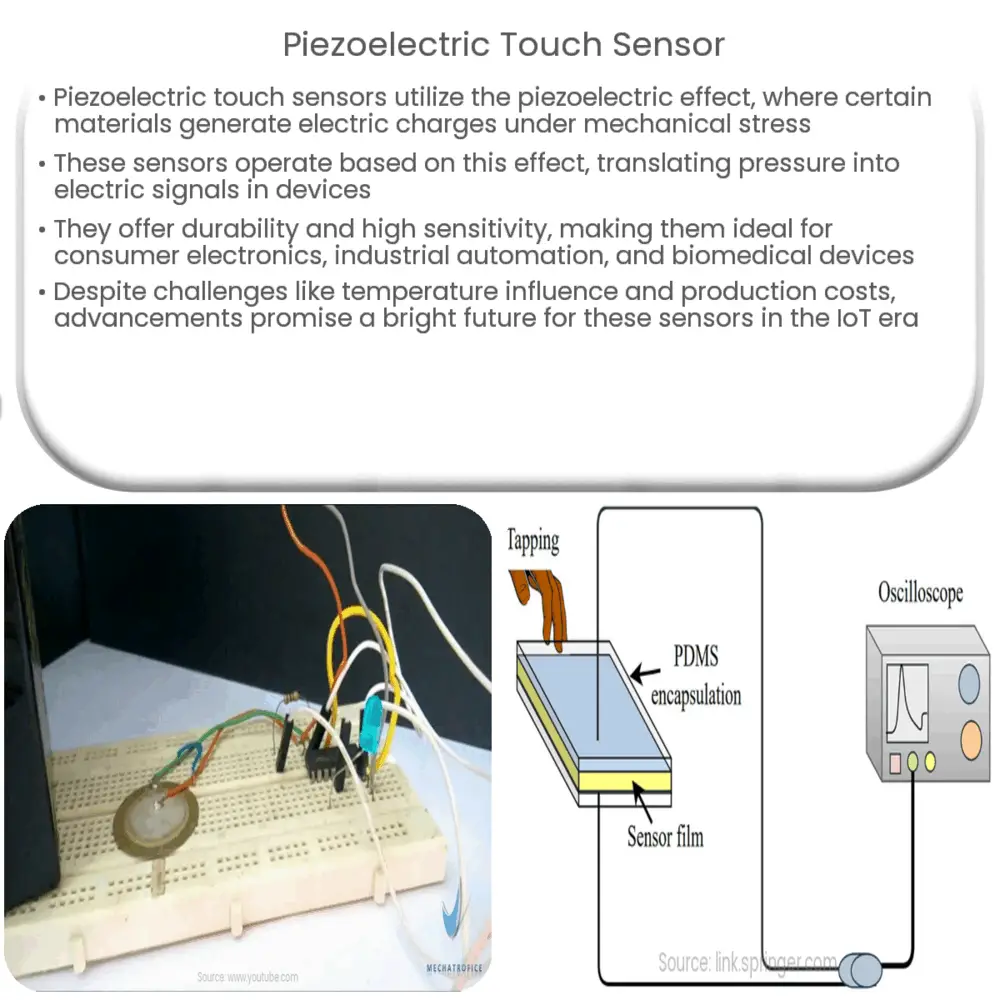Explore the world of piezoelectric touch sensors, their working principles, benefits, applications, challenges, and future prospects.

Introduction to Piezoelectric Touch Sensors
The piezoelectric effect, a phenomenon where certain materials generate an electric charge in response to applied mechanical stress, has found a myriad of applications in modern technology. Among these, piezoelectric touch sensors stand out as an innovative solution that combines simplicity, efficiency, and versatility.
Understanding Piezoelectricity
Piezoelectricity is derived from the Greek word ‘piezein’, which means ‘to squeeze or press’. When pressure is applied to certain materials, they generate an electrical charge. This unique property is inherent to certain crystalline materials, including quartz, topaz, cane sugar, and even some types of ceramics and bones.
- Direct Piezoelectric Effect: This is where the generation of electricity occurs when mechanical stress is applied.
- Converse Piezoelectric Effect: Here, mechanical deformation is observed when an electric field is applied.
Both effects are extensively used in different types of sensors, including the piezoelectric touch sensor.
Piezoelectric Touch Sensors: Working Principle
A piezoelectric touch sensor works based on the direct piezoelectric effect. When a user interacts with the sensor, pressure is applied to the piezoelectric material. This mechanical stress results in the generation of an electric charge, which can then be detected and processed.
To illustrate, consider a touch-sensitive button on a modern appliance. The button includes a piezoelectric material—when you press the button, the pressure exerted creates an electric charge. This charge is then detected by the system, which interprets it as an input signal and performs the desired action.
Key Benefits of Piezoelectric Touch Sensors
Piezoelectric touch sensors offer numerous benefits, primarily stemming from the unique properties of piezoelectric materials. These include:
- Durability: Piezoelectric materials are often robust and resistant to environmental changes, making them suitable for a wide range of conditions.
- Sensitivity: These sensors can detect even the slightest pressure changes, resulting in high sensitivity.
Given these benefits, piezoelectric touch sensors are rapidly finding their place in various applications, including consumer electronics, industrial automation, and even biomedical devices.
Applications of Piezoelectric Touch Sensors
The advantages of piezoelectric touch sensors make them ideal for numerous applications. Let’s explore some of these.
- Consumer Electronics: In consumer electronics, these sensors are often used in touch screens and buttons on various devices like smartphones, tablets, and smart home appliances. Their sensitivity and durability make them a preferred choice for these applications.
- Industrial Automation: Piezoelectric sensors provide reliable, non-contact sensing in industrial environments. They can be used to monitor machine vibrations, detect the presence or absence of objects, and even measure fluid levels.
- Biomedical Devices: In the biomedical field, these sensors are used in various diagnostic and therapeutic devices. For example, they can be used in pulse detectors and blood pressure monitors.
Challenges and Future Prospects
Despite their advantages, piezoelectric touch sensors also face certain challenges. The quality of the sensor’s output can be influenced by temperature variations, and the sensors themselves can be relatively costly to produce. However, advancements in material science and manufacturing techniques are expected to address these issues in the future.
The future of piezoelectric touch sensors looks promising. With the advent of smart cities and the Internet of Things (IoT), there is an increasing demand for efficient, reliable, and sensitive touch sensors. Piezoelectric touch sensors, with their unique capabilities, are well-positioned to meet this demand.
Conclusion
Piezoelectric touch sensors are an innovative application of the piezoelectric effect, offering a combination of sensitivity, durability, and versatility. While they face some challenges, ongoing advancements are expected to drive their adoption in a multitude of applications, from consumer electronics to industrial automation and biomedical devices. As our world becomes more connected, piezoelectric touch sensors will continue to play a pivotal role in enabling and enhancing this connectivity.

